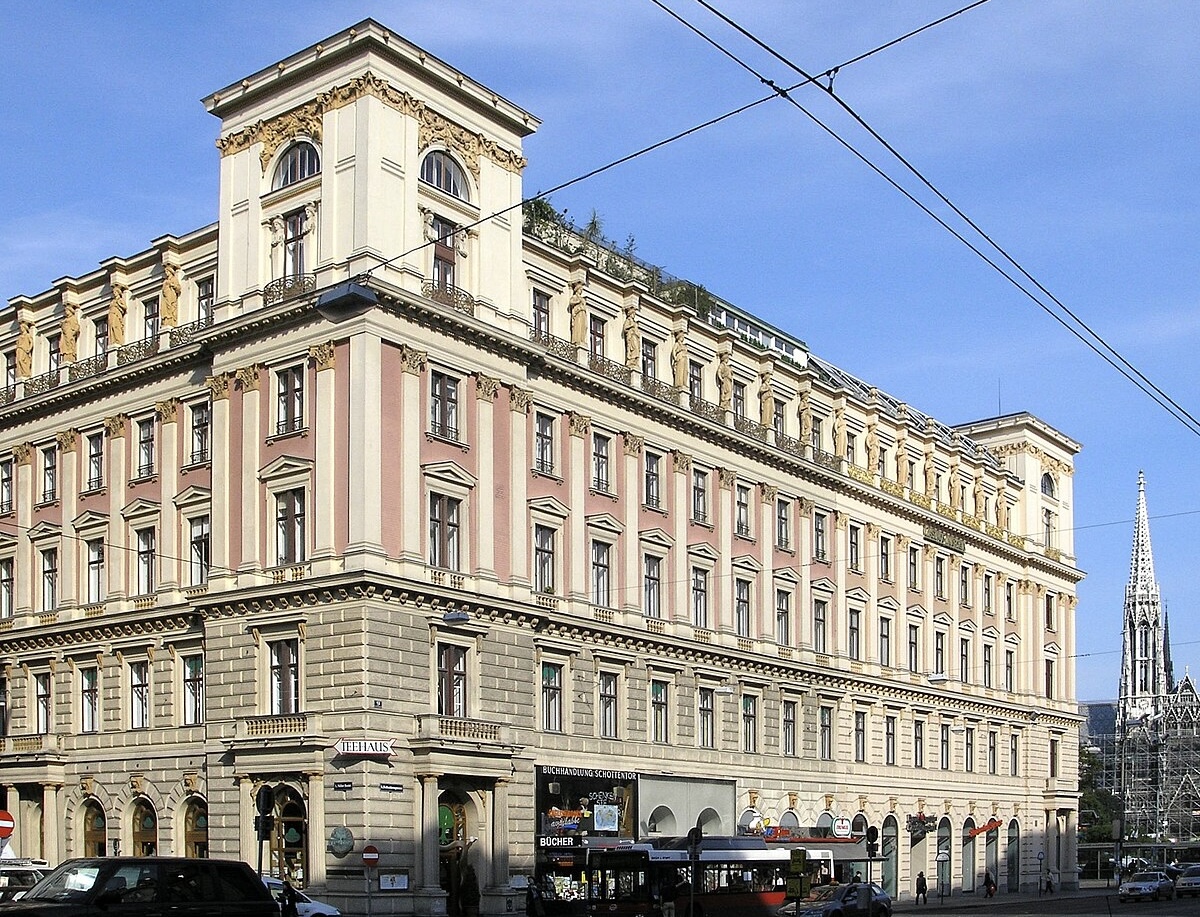Experience Travel Insights
From Fortune to Fugitives: The Ephrussis. Travel in Time
by Long Lin-Maurer • September 26, 2025

The Ephrussis Travel in Time: A Saga on Vienna’s Ringstrasse
To stand on the Schottentor, where Vienna’s magnificent Ringstrasse arcs in a grand sweep of imperial ambition, is to stand at a crossroads of history. Amidst the neo-Gothic Votivkirche and the classical grandeur of the University, one particular building holds a story of staggering ascent and devastating loss: the Palais Ephrussi. More than just a marvel of 19th-century architecture, this stone palace is the silent anchor of an Ephrussi family chronicle that traverses empires and continents. In a way, the Ephrussis travel in time through this narrative, a story so rich it encapsulates the very soul of Central Europe’s complex past, beginning not in Vienna, but in the bustling port of Odessa.
Come and experience travel!
Personally designed, seamlessly delivered – your journey, our expertise!
We are a boutique travel agency and consultancy specializing in Hub & Spoke Tours across Central Europe, the Benelux and the Dolomites.
From Odessa Grain Merchants to Imperial Capital
The Ephrussi dynasty, often dubbed “the Rothschilds of the East,” did not emerge from the established banking families of Western Europe. The Ephrussi family’s historical journey begins in the shtetl of Berdichev, in what is now Ukraine. Charles Joachim Ephrussi, a clever grain merchant, saw the future in burgeoning global trade. He moved his family to Odessa, the gateway of the Russian Empire, where as prominent Odessa grain merchants, they built a colossal fortune exporting Ukrainian wheat to the world.
Like many successful Jewish families of the era, the Ephrussis understood that diversification was key. They expanded west, establishing powerful banking branches in Paris and Vienna, becoming a notable Jewish banking family on the European stage. Ignace von Ephrussi arrived in Vienna and quickly established Ephrussi & Co. as a formidable financial institution. He was a symbol of the Gründerzeit, the “founders’ era” of liberal optimism in the Austro-Hungarian Empire. For families like the Ephrussis, Vienna was a promise of acceptance—a future where heritage would not be a barrier to full participation in society. Their ascent was meteoric, culminating in their ennoblement by Emperor Franz Joseph I. They had arrived.
The Palais Ephrussi: A Symbol of 19th-Century Vienna
To commemorate this arrival, Ignace commissioned a palace on the newly constructed Ringstrasse Vienna, the most prestigious address in the Empire. He chose the great architect Theophil Hansen, a master of the neo-Renaissance style. The Palais Ephrussi, completed in 1873, was more than a home; it was a statement. Its façade, adorned with classical figures, projected stability, culture, and immense wealth in the heart of Vienna 19th-century society. The interiors were a symphony of marble, gold leaf, and painted ceilings, including a magnificent ballroom depicting scenes from the myth of Prometheus—a fitting allegory for a family that had brought the fire of commerce to Europe.
Within these opulent rooms, the Ephrussis lived at the apex of Viennese society. They were patrons of the arts and hosts of glittering salons where the city’s intellectual and financial elite mingled. Their world was the Vienna of Gustav Mahler, Sigmund Freud, and Gustav Klimt. The Palais was not merely a backdrop but a vessel for the family’s aspirations and their profound belief in the permanence of their identity, solidifying the Ephrussi legacy through time.
The Hare with Amber Eyes: Witness to the Ephrussis’ Story Across Generations
In the 1870s, a wedding gift arrived from Paris for Viktor and Emmy Ephrussi in Vienna: a collection of 264 netsuke—exquisite, miniature sculptures from Japan. This netsuke collection, depicting everything from animals to mythical creatures, became the silent witnesses to the family’s intimate history. They became a physical manifestation of the Ephrussis’ story across generations.
Stored in a glass vitrine in Emmy’s dressing room, the netsuke were handled by Ephrussi children, who used them as toys. They absorbed the scent of Emmy’s perfume and overheard the private conversations that echoed through the grand apartments. They bore witness to births, marriages, and the everyday moments of joy and sorrow that define a family’s life. While the Palais represented the family’s public face, the netsuke held their private soul, a tangible link between generations that would ultimately hold their fractured narrative together.
Come and experience travel!
We design bespoke travel experiences with a perfect balance of cultural depth, efficiency and comfort.
Specializing in seamless hub-and-spoke journeys, we create well-paced, immersive itineraries tailored to your interests.
The Anschluss and the Cruelty of Nazi Plunder
The world the Ephrussis had so carefully built proved tragically ephemeral. In March 1938, the Anschluss brought Nazi Germany to Vienna, and with it, an end to the dream of Jewish assimilation. The vibrant city that had nurtured the Ephrussis turned on them with terrifying speed. The Palais Ephrussi, a symbol of their success, became a target.
Nazi officials requisitioned the palace, turning it into their headquarters. The family was subjected to brutal humiliation as their bank was seized and assets stripped. Their priceless art collection was systematically looted in a devastating campaign of Nazi plunder. Viktor Ephrussi was forced to sign away his fortune before fleeing into exile. In the chaos, one treasure was overlooked. Anna, the family’s loyal non-Jewish maid, understood the personal significance of the netsuke. In an act of quiet courage, she smuggled the tiny figures out, hiding them in her mattress for the duration of the war. While the grand empire of the Ephrussis was dismantled, this small, hidden world of memory survived.
A Legacy Reclaimed: Edmund de Waal and the Ephrussi Saga Through History
After the war, the surviving members of the Ephrussi family were scattered across the globe. Elisabeth de Waal, a daughter who had escaped to England, returned to Vienna and found Anna, who returned the netsuke collection—the only tangible remnant of their former life. The collection traveled with Elisabeth and later her son to Japan, their journey coming full circle.
Decades later, Elisabeth’s great-nephew, the ceramicist Edmund de Waal, inherited the collection. Fascinated by these silent objects, he began exploring the Ephrussi family past, a quest that resulted in the celebrated memoir, The Hare with Amber Eyes. His work resurrected the Ephrussi saga through history, transforming them from a historical footnote into a poignant symbol of a lost world. His book is a masterclass in tracing the Ephrussi family timeline from immense wealth to devastating loss. Today, the Palais Ephrussi still stands, housing offices and a casino. Yet the story it holds has never been more alive. In a final, fitting chapter, the netsuke were exhibited at Vienna’s Jewish Museum, a short walk from where their journey began, completing a remarkable journey through the Ephrussi family history and reminding us that history is held not just in grand monuments, but in the small things we have the courage to remember.
The Ephrussis Travel in Time: Key Cultural & Historical Resources
- The Hare with Amber Eyes: Exhibition at the British Museum
– Explore the narrative of the netsuke collection through an exhibition dedicated to Edmund de Waal’s celebrated book. - The Ephrussis. A European Journey: Exhibition at the Jewish Museum Berlin
– Delve into the comprehensive family history and their profound impact across European capitals and beyond. - Overview of the Ephrussi Family on Jewish Virtual Library
– A concise historical and genealogical account of this prominent Jewish banking and cultural dynasty. - Palais Ephrussi on Vienna History Wiki
– Learn about the architectural and social significance of the Ephrussi family’s grand residence on Vienna’s Ringstrasse. - Netsuke Collection at the Victoria and Albert Museum
– Discover the intricate art form of netsuke, central to the family’s story, through a renowned museum’s collection. - Jewish History in Vienna on Jewish Virtual Library
– Gain context on the vibrant, yet complex, Jewish community in Vienna, particularly during the Ephrussis’ influential era. - Austrian Commission for Provenance Research
– Understand the broader historical and ethical context of art restitution in Austria, relevant to the Ephrussi family’s losses. - Fin de Siècle Vienna at Wien Museum
– Explore the cultural and artistic ferment of Vienna’s turn-of-the-century, a backdrop to the Ephrussis’ high society life. - Ephrussi as Patrons of French Impressionism (National Gallery of Art)
– Understand the family’s significant role as art collectors and patrons, extending beyond netsuke to key European art movements. - Edmund de Waal RA: Artist and Author Profile
– Learn more about the acclaimed author who brought the Ephrussi story to global attention, from a prominent arts institution.
